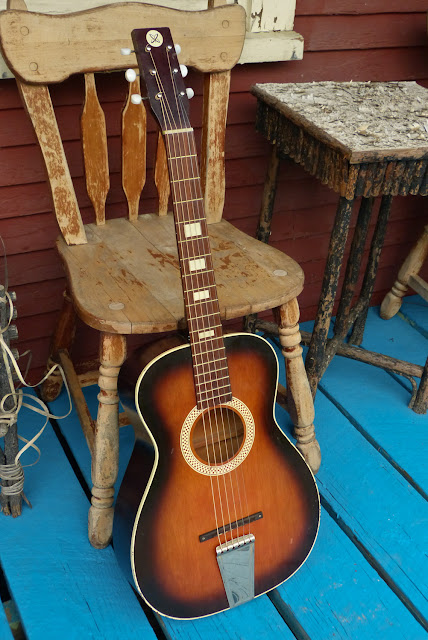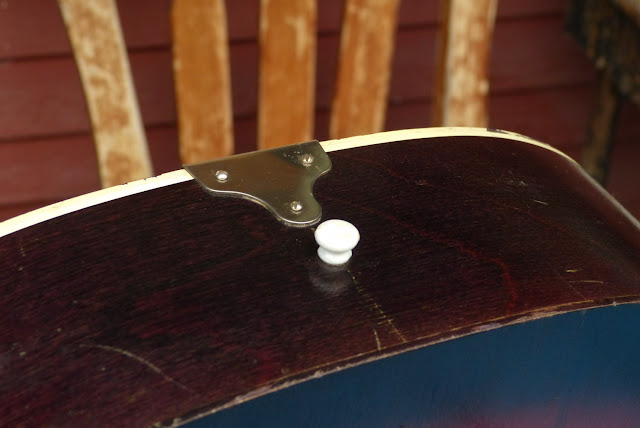1970 Harmony-made Sears Tailpiece Parlor Guitar
I'm assuming the SR logo at the headstock stands for Sears & Roebuck, but that would be odd as I'm used to seeing Sears-sold guitars with the Silvertone label. Anyone know for sure?
Anyhow, this is essentially identical to scores of Harmony guitars made to the same mold (but with different trim) starting from the mid-late '30s and running clear through the '60s and into the '70s. It's a "parlor" size (just a hair under 0 size with a 13" lower bout) and has a 24 1/8" scale length, making it a standard size for the '20s and '30s but pretty small compared to the average guitar these days. The body is ladder-braced and made entirely of solid birch and the neck is poplar. The fretboard and bridge are stained mystery-wood but probably poplar as well.
I picked this one up in quite good shape and it's entirely original and crack-free. It needed a fret level/dress, side dots, compensation to the bridge, and a good setup to get it going. At the same time I installed a concealed "bolt" at the neck block to make sure that the neck stays-put in the future as I didn't do a reset on it (it didn't need one -- the angle was spot-on and the fretboard extension dips slightly down from the plane of the other board -- as it should).
After work it's playing on-the-dot with 3/32" EA and 1/16" DGBE action at the 12th fret and strung with 52w-12 strings and toting a straight neck. These guitars have a dry, punchy, growly tone that really, really suits country-blues playing and gives many larger guitars a good run for their money in terms of volume and oomph -- though the bass is decidedly snappy and the guitar is almost entirely mids-focused like an archtop.
The faux-rosewood paintjob on the board is endearing. The position markers are sprayed-on, too, but my new side dots are "real." The frets are brass and have a good amount of life left to them.
The nut is plastic and has a 1 3/4" width. The board is flat (non-radiused) and the back of the neck is in a medium, round, C-shaped profile.
The checker "rosette" is a nice touch.
I compensated this bridge for the B and high E strings and then attached it firmly in place with a couple of tiny screws installed through the bridge wings. I find that a lot of players of this type of guitar knock their bridges all about when they're squeezing "tone" out of them and this solution is the most practical for keeping a rough player in tune.
As an aside -- these flat-plate, stamped tailpieces add an interesting sustain/mild reverb effect to these guitars that's subtle and outside the usual overtone-intense tailpiece setup's sound.
While there are a few scuffs and bumps on the guitar, it was nice to see one come to me in relatively good shape -- especially compared to the state I mostly see these in (click here to check out a 1930s version of this design undergoing a lot of work).
"Made in USA" is proudly stamped on the headstock, but the tuners are actually Japanese units. Harmony was really hurting by the late '60s and this cost-saving choice was clearly meant to curtail falling income. Still -- these tuners work as well as the American-made units mostly seen on this grade of Harmony product -- so why not?
Yes -- the "binding" is painted-on.
The F-70 is for 1970.
Here's my concealed "neck joint reinforcement." I think it's a good idea to make your own luck if you can.



















Comments